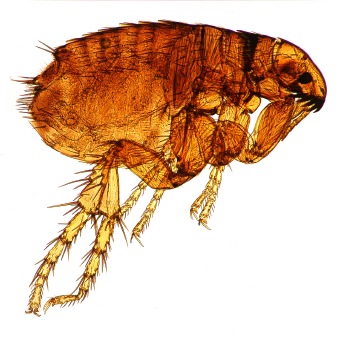
INTRODUCTION. This flea receives its common name of oriental rat from the fact that its favorite hosts are rats, especially the Nonway rat which is thought to be of central Asian origin. This flea's greatest importance is that it is the principal vector of bubonic plague and murine typhus from rats to humans. Oriental rat fleas are of worldwide distribution and found throughout the United States, but most commonly in seaport areas; scarce in northern areas but found as far north as Washington, Minnesota, and New Hampshire.
RECOGNITION. Adults about 1/16" (2-2.5 mm) long. Body laterally flattened (side to side); wingless. Color reddish brown. Head with front rounded, ocular bristle inserted in front of eye; genal comb lacking. Pronotal comb lacking; mesopleuron (side of mesothorax) divided by a vertical rodlike thickening; thorax not reduced, dorsum (top) equal to or larger than 1st abdominal segment. Abdominal terga (dorsal plates) 2-6 with a single row of bristles; spermatheca (internal sperm storage organ; towards rear of abdomen) dark-colored, visible through exoskeleton in alcohol collected specimens. In addition, antennae short, 3-segmented; ocelli lacking; legs long, coxae large, tarsi 5- segmented; usually jumping insects; mouthparts piercing-sucking with well-developed palps.
Mature larvae about 1/8-1/4" (3-5.2 mm) long. Larvae whitish, slender, eyeless, and leg¬less. With a well-developed head. Anal struts/hooks 2, small. With moderately long, back¬ward-projecting hairs (setae) encircling each segment. Last abdominal segment (10th) with 3 ventrolateral hairs (setae). Description is same as for dog and cat fleas.
Females lay 4-8 eggs after each blood meal. Eggs are sticky but usually fall off the host or are deposited in the nest. The minimum temperature for egg development is 54°F/12°C. Larvae usually feed on organic matter including droppings from adult fleas but cannot develop solely on a blood diet; they can also successfully develop solely on grain stored in grain sacks. Because the larvae lack a closing mechanism on their spiracles, they require high humidity for development and move to areas of high humidity. Exposure to 0% RH at 72°F/22°C for 24 hours is lethal but at 90% RH the lethal temperature is 97°F/36°C. Larvae go through 3 molts and then pupate. Successful pupation and emergence requires 64-95°F/18-35°C and 60+% RH. Females emerge 3-4 days before males. If well fed, adults may live for a year or more in the lab, but probably only 2-4 weeks in the wild. The life cycle (egg to egg) can be completed in as few as 4-8 weeks.
HABITS. Unfed adults are attracted to light but fed adults shun light. Adults have respond¬ed positively to the odor from a favorable host at up to 12" (30 cm) and were able to dis¬tinguish it from nonhost species. Adults can jump as far as 9.4“ (24 cm) horizontally and 4.3" (11 cm) vertically.
The favorite host is the Norway rat (Rattus norvegicus (Berkenhout)), but the oriental rat flea is also found on the cotton rat (Sigmodon hispidus Say & Ord), roof rat (R. rattus Linnaeus), the house mouse (Mus musculus Linnaeus), cottontail rabbits (Sylvilagus spp.), and the California ground squirrel (Spermophilus sp.). Oriental rat fleas readily bite and feed on humans. The medical concern is that these fleas are the principal vector of both bubonic plague and murine typhus. The transmission is primarily from rats to humans although other wild host reservoirs of these disease organisms can be involved.
CONTROL. Flea control is a 4-part process.
1. Wild animals such as rodents, opossums, etc., which are nesting in or frequently visiting the structure must be prevented from entering the structure and controlled with appropriate trapping devices or baits.
2. If the pet has fleas at the time of treatment, the pet owner must arrange for the pet to be treated. Treatment may be done by a veterinarian, grooming parlor personnel, or by the pet owner, but must be done on the day of treatment and either before or while the premises are being treated. 3. Indoor control. The homeowner or occupant must do the following just before the flea treatment: Remove all items such as toys and pillows off the floor or carpet; remove all articles from under beds, on closet floors, and from under furniture; vacuum all upholstered furniture, floors, and carpeting, paying particular attention to the foot of the furniture on which the pet rests, under furniture, and wall-floor junctions. The vacuum bag must be immediately removed and put into a plastic garbage bag, the top sealed, and then placed in an outside garbage receptacle or burned. Thoroughly clean all areas frequented by cats, e.g. table tops, refrigerator tops, window sills, counters, etc. Cover aquariums and turn off the pumps prior to the treatment. Be sure to remove all pets, including birds.
3. Outside control. Minimally, spot treatment should be done. This consists of treating with an appropriately labeled pesticide and light-stable IGR, all rodent burrows and nesting areas as well as every place the pet rests, naps, or sleeps which are typically cool areas such as next to the building’s foundation, porch, etc., or under a bush or tree. In addition, band treatment is often helpful, especially if overall treatment is not going to be done. Band treatment is done with an appropriately labeled pesticide which is applied in a 6-10 foot band around the perimeter of the building. For dogs confined to a fenced-in- yard, also treat the 3-4 feet adjacent to the fence on the side to which the dog has access. If the infestation is severe, overall yard treatment may be required and an appropriately labeled pesticide should be used. Wettable powder and microencapsulated formulations are particularly effective outdoors.
Our pest management treatment consists of applying an appropriately labeled pesticide and/or IGR as per label instructions with thoroughness being the key to success. We will use an IGR (insect growth regulator) on the initial treatment and reapplied as per label instructions every 3-6 months throughout the flea season. For accounts that are susceptible to flea activity, we'll recommend that the IGR alone be applied prior to the beginning of the next flea season as a preventative measure.
If wild host animals such as rodents, opossums, etc. have been a problem in the crawl space, attic, and/or wall voids, such area(s) must also be thoroughly treated.
Please call us today for a free estimate for the elimination of these fleas.


